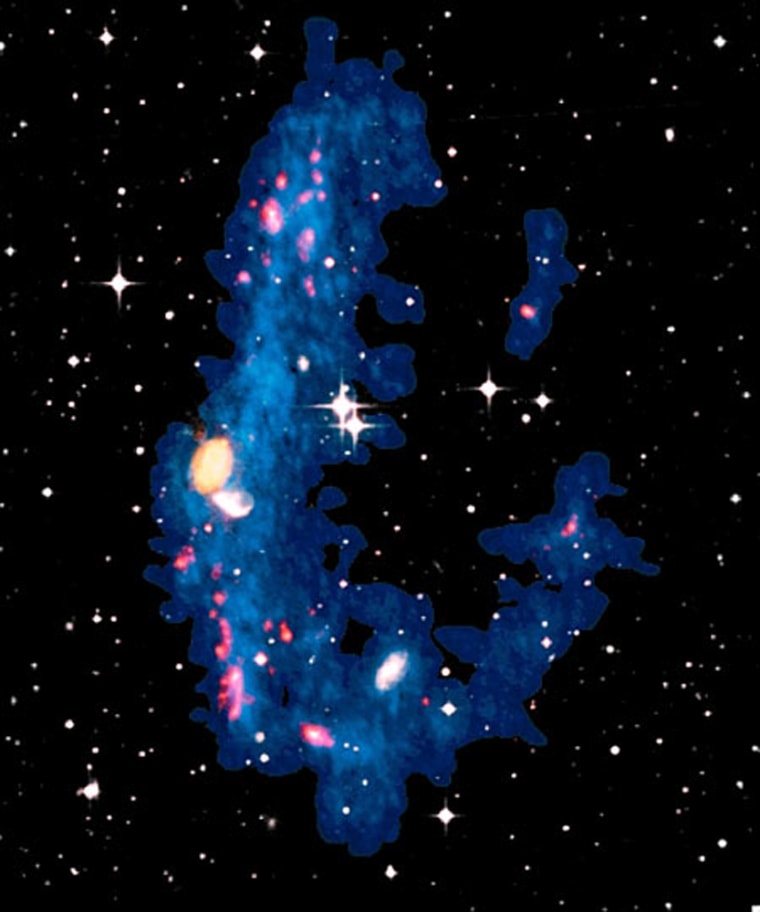The universe may be filled with shining stars, but nearly 85 percent of all matter can't be seen, calculations show. In the hunt for the invisible, astrophysicists have turned up a small but new hiding place for mysterious dark matter: "recycled" dwarf galaxies produced from nasty galactic collisions.
The discovery, detailed Thursday in the online version of the journal Science, challenges the notion that dark matter hangs out in halos around large galaxies. Instead, it might be found within the galaxies.
Dark matter acts as gravitational glue, holding millions or billions of stars together in galactic globs or disks. Without it, "our own galaxy should have fallen apart by now," said Frederic Bournaud, an astrophysicist with the French Atomic Energy Commission. "So dark matter — this unseen force — is somewhere keeping it glued together."
In the dark about dark matter
Scientists have no firm idea what dark matter actually is. They haven't even agreed on a single definition for the mysterious stuff, because they can only guess as to what it's made of. While dark matter is a source of gravity and reacts with regular matter on large scales, it has no measurable effect on small scales (for instance, within our solar system), there is no picture of it and there's no known way to detect it directly.
Conventional matter, called "baryonic" matter, is the stuff of plants, rocks, stars and things we can touch or at least see. But some baryonic matter is not easily seen, because it's in the form of cold gas or faraway, dark, burned-out stars. Some researchers use the term "dark matter" to refer to this hard-to-see regular matter.
Slideshow 12 photos
Month in Space: January 2014
But the overwhelming majority of unseen matter is probably the highly unconventional, yet-to-be-described "non-baryonic" matter, and most scientists limit their definition of dark matter to this strange form.
Disagreements aside, so far the bulk of dark matter has been detected only indirectly. One method, for example, takes a galaxy's visible matter, calculates how fast it should be moving and then compares that to the actual, observed speed. For large galaxies, the calculations show visible matter accounts for only 10 percent of the mass that should be there.
But by combining telescope images, calculations and computer models, Bournaud thinks he and his team might be a little closer to finding and identifying more of the universe's missing mass.
Galactic hit-and-run
To discover more clues about dark matter, the astrophysicists aimed the Very Large Array of radio telescopes in New Mexico at NGC5291, a galaxy cluster about 200 million light-years away. It resembles a ring, crowned with one large galaxy at the center and studded with smaller dwarf galaxies in a cloud of cosmic debris.
How does such a curious group of galaxies form?
"About 360 million years ago a large galaxy collided with NGC5291, which used to be a spiral galaxy," Bournaud said. Several suspects are in the area, but IC4329 is the prime candidate —with a lined-up trajectory and six times the mass of NGC5291, it has remained relatively unchanged from the probable cosmic collision, much as a car often remains unscathed after hitting a cyclist.
Simulated help
If dark matter does hang out at the edges of large galaxies, little or none should be found in the recycled dwarf galaxies. But Bournaud has discovered that visible matter makes up only one-third of the mass in the tiny galaxies — so large galaxies probably contain most dark matter within their galactic boundaries, not in a halo around them.
Bournaud thinks about half of the unseen mass in the recycled galaxies is plain old hydrogen gas. "But that's only a guess," Bournaud said, adding that telescopes should eventually be able to detect it. Regardless of whether or not the hidden matter is regular matter or dark matter, current theories about recycled dwarf galaxies and dark matter location are being put "to the test," according to the study.
Bournaud gives some of credit for the discovery to dramatic advances in computing. "Even 10 years ago, simulations were far behind telescope observations," he said. Like police reconstructing accident or crime scenes by combining eyewitness reports and forensic measurements, "today astrophysicists are combining what they see with computers models to make discoveries."
The next step in adding weight to the theory, Bournaud said, is to look at other recycled dwarf systems. "If we can better understand galaxy formation, we can find more dark matter," he said.

